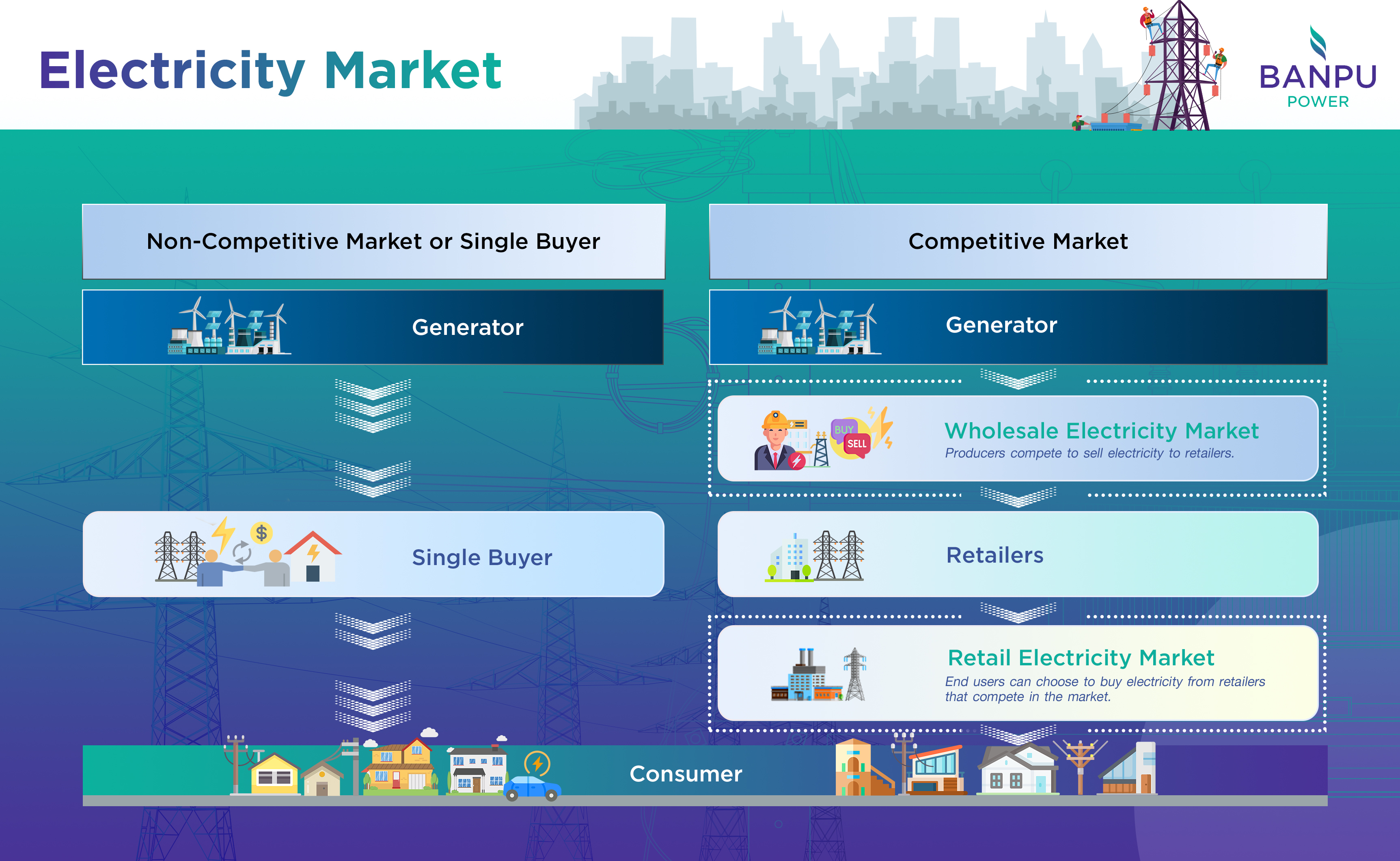Uncover “Merchant Power Market” to Seize on Unprecedented Opportunities for Electricity Producers and Consumers
The concept of “Merchant Power Market” has been widely put up for discussion in the past few years, which leads to many questions raised by consumers, for instance, what made countries such as the United States, Australia, Japan adopt a merchant power market? What steps or duration are required for the transition from single buyer market to merchant power market? How does each group of consumers or electricity users need to adjust? Is electricity pricing in the merchant power market really cheaper? And most importantly, what benefits will consumers get when they are in the merchant power market?
Dr. Kirana Limpaphayom, Chief Executive Officer of Banpu Power or BPP, said, “Over 20 years of BPP’s presence in the power business in various countries, we have experienced electric power consumption in several types of electricity market. We thus come to terms with the transition from a single buyer market to a merchant power market requires different duration to completion, depending on each country’s contexts such as the energy policy, electricity demand, types of fuel used in power generation, per capita income and so on. It’s fair to point out that the transition is aimed at putting consumers’ maximum benefit as top priority in which it must promote power system stability, economically worthwhile, and environmentally friendliness.”
The road to readiness: The transition to a merchant power market
Questionable factors influencing a country to weight up their readiness for transition to a merchant power market include 1) There is a sufficient number of electricity producers and distributors in the market for consumers to choose; 2) None of electricity producers in the market has enough influence over the market in terms of price setting which will result in competitive electricity prices based on the market mechanism, 3) An adequate infrastructure of electricity trading has been developed to accommodate the merchant power market; and 4) There is clear transitional policy plan to handle transition. Considering the above factors, each country is taking different durations on a transition to a merchant power market.
In Japan, it takes about 15-16 years to complete the transition that took place from 2000 to 2016. It began with the initial opportunity given to a group of customers that consumed higher levels of electricity such as industrial plants and office buildings to be able to buy electricity from electricity producers themselves. It expanded to medium-sized customers such as hospitals, factories, SME businesses and then household customers or small consumers consecutively based on levels of power consumption. This coincided with the development and preparation of various relevant systems such as power purchase agreements, electric power distribution systems, payment systems to continually support and facilitate electricity producers. Meanwhile, the government remains responsible for maintaining and managing infrastructure such as transmission lines because it is not economically viable for the private sector to build additional transmission lines without supporting needs.
In 1996, countries in the European Union (EU) began the transition process and then fully became a merchant power market in 2009. The transition started with the government’s policy framework with the commitment to shift to a merchant power market within the specified duration in order that those involved in the electricity supply chain, including electricity generators, transmission line administrators, retailers and distributors, and consumers, had sufficient time for preparation.
“Energy cost”, a significant factor that influences electricity costs
It’s fair to point out that any type of electricity market will have to experience electricity bill volatility due to the cost of energy in generating electricity that consists of “fuel price” and “cost of electricity generation” of each country. The impact is divided into 2 phases, including the short-term impact which comes from fuel cost especially the volatility of oil and shale gas prices, and the medium-term or long-term impact that is a result of other economic figures such as interest, inflation rate, all of which affect the cost of production in terms of labor or equipment required for construction or improvement on future operations. Furthermore, each electricity market will be affected differently.
In the single buyer market, the government purchases all the electricity, generated from electricity producers and acts as the owner and controller on the operation of transmission lines and distribution systems for power distribution to consumers. Electricity price adjustment results from fuel prices and other costs. The overall market cost is averaged in all the areas it manages. Electricity price adjustment that reflects production costs tends to take more time than a merchant power market’s system due to restrictions on price adjustments according to the government mechanism. However, there are some advantages, for instance, the government takes charge of electricity price control that benefits small consumers. They can also take intervention by locking electricity bills or provide other support. However, this type of market may not effectively reflect changes in market competition.
In the merchant power market, it has the pricing mechanism that determines the purchase – sale activity. The power generators can sell the electricity they generate to private companies through the wholesale market system. The production costs come from the energy, which is the cost of generating electricity per unit, congestion costs in the transmission system which are averaged from each area and the cost of transmission losses which come from power loss during transmission system. When electricity is sold in the retail market, it generates marketing and electricity distribution costs to consumers. The advantage of this power market is that private companies competing against each other in the market are often efficient in managing fuel costs and capable of maintaining price stability to some extent because most of them have long-term power purchase agreements. In addition, the price mechanism is effective due to disclosure in the trading price which leads to competition among private companies. However, another critical point is that if production costs fluctuate, it may result in the volatility of retail electricity bills. Electricity prices on the market might remain volatile according to the actual cost of production.

What benefits that consumers will receive from the merchant power market?
On the side of large electricity consumers, they will benefit from their operating costs because they have access to the electricity at the lowest price. On the side of retail customers, they will benefit from the competition between electricity producers and retailers which results in competitive prices according to the market mechanism. Furthermore, the high competition through marketing product design enables consumers to be spoiled for choice of electricity producers. Similar to choosing a cellular service provider for our smartphone, we can opt for an electricity producer that suits our electricity consumption behavior, otherwise we can choose based on energy sources used for generating electricity such as renewable energy or locally fuel source in order to promote local benefit, for example, in Japan where local tax policies are involved.
Energy Trading
In the merchant power market, the energy trading platform is an important piece of the puzzle that helps manage risks or handle volatilities that may occur in the system on both power producers and consumers’ side. This includes creating an opportunity to make more profits in which an electricity trading platform runs a process similar to trading assets on the stock exchange. In other words, it is a process that takes place in the wholesale electricity market and enables us to buy electricity at the desired price, and also serves as a channel to make an immediate profit from the difference between the current price and the price at the time of delivery. The most influential players in the market are power producers, financial institutions and large-scale investors.
For power producers, energy trading is a channel used to distribute electricity freely according to its self-competitiveness with the use of financial tools to help reduce price fluctuations and volatility. This allows producers to better assess revenues and reduce risks. In the meantime, large-scale investors can look for profitable opportunities while waiting for deliveries and effectively take risks on price and currency exchange rates by means of risk management tools. The energy trading market also leads to competitive pricing that indirectly benefits consumers.
In the transition from a single buyer market to a merchant power market, consumers will benefit from market competition that lowers electricity prices. However, consumers have to deal with more volatility of electricity prices. Therefore, it requires a mechanism and a duration to prevent potential risks that may occur. From the consumer’s viewpoint, it requires a study of the decision-making model of electricity purchasing that suits their behavior in electricity consumption. From the retailer’s point of view, it requires a sales model or a marketing strategy to attract customers. From the electricity producer’s viewpoint, it requires an understanding of global energy trends and consumer needs along with expertise in cost management for power generation and building long-term competitiveness to create benefits and values for all groups of people from upstream to downstream.
To read the article, “Merchant Power Market: A Trend in the Global Energy Business”, go to https://www.banpupower.com/activities/merchant-power-market/?lang=th)
References
1. The official websitemaintained by the Ministry of Economy, Trade and Industry of Japan
www.enecho.meti.go.jp/en/category/electricity_and_gas/electric/electricity_liberalization/what/
2. The official website of the European Commission’s science and knowledge service
https://ses.jrc.ec.europa.eu/evolving-electricity-markets-schemes
About BPP
Banpu Power Public Company Limited is a leader in power generation and distribution in the Asia-Pacific, including Thailand, Lao PDR, China, Japan, Vietnam, Indonesia, Australia and the U.S., with a position of “We ARE (Affordable, Reliable, and Eco-friendly) Power for the Sustainable World”. For more than two decades, BPP has been committed to operational excellence to achieve efficient power generation while deploying high-efficiency, low-emissions (HELE) technologies that are safe and environmentally sound in accordance with its Greener & Smarter strategy. The Company is continuously moving forward to reach a total equity-based power generation capacity of 5,300 MW within 2025.



